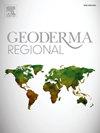Nitrogen loss due to nitrate reduction in the soil profile depends on the type of cropland
IF 3.3
2区 农林科学
Q2 SOIL SCIENCE
引用次数: 0
Abstract
The N cycle in shallow soil is affected by the cropland type; however, little is known about nitrate loss in deeper soil layers in upland and paddy fields. We employed a soil slurry-based 15N paired tracer technique to investigate denitrification, anaerobic ammonium oxidation (anammox), and dissimilatory nitrate reduction to ammonium (DNRA) rates in the 0–200 cm soil profile of paddy and uplands (40 cm per layer) in the Ningxia Yellow River irrigation district. The rates of N loss of denitrification and anammox ranged from 0.29 to 9.06 nmol N g−1·h−1. In the paddy soil, the rates of N loss decreased from the 0–40 cm layer to the 160–200 cm layer, and the rates ranged from 0.74 to 9.06 nmol N g−1·h−1, in the upland soil, the rate of N loss exhibited a decreasing trend from the 0–40 cm layer to deeper layers, followed by an increase from the 80–120 cm layer to the 160–200 cm layer, with values ranging from 0.29 to 1.99 nmol N g−1·h−1. Denitrification was the major contributor to N loss in paddy soil, accounting for 66.59–85.47 % of nitrate loss. In addition, paddy field soils presented a more diverse N-reducing bacterial community than uplands soil did, with Chao1, ACE and Shannon index in the bacterial diversity analysis being greater in paddy fields than upland soils. Desulfobacca, Fimbriimonas, Thiobacillus, Anaerolinea, Anaeromyxobacter and Syntrophobacter presented relatively high abundances in the 0–40 cm soil profile in the paddy fields. The nitrate reduction rate in the soil profile was determined by crop type. The nitrogen reduction loss in deep soil layers cannot be ignored, and long-term crop types can impact soil texture and microbial community structure, ultimately leading to differences in the diversity of nitrogen-transforming microorganisms.
土壤剖面中硝酸盐减少造成的氮损失取决于农田类型
浅土层氮素循环受耕地类型的影响;然而,人们对旱地和水田深层土壤中硝酸盐的流失知之甚少。采用土壤浆料- 15N配对示踪技术,研究了宁夏黄河灌区稻田和高地0 ~ 200 cm土壤剖面(每层40 cm)的反硝化、厌氧氨氧化(anammox)和硝酸异同化还原成铵(DNRA)速率。反硝化和厌氧氨氧化氮损失率为0.29 ~ 9.06 nmol N g−1·h−1。水稻土氮素流失率在0 ~ 40 cm到160 ~ 200 cm之间呈下降趋势,为0.74 ~ 9.06 nmol N g−1·h−1;旱地土氮素流失率在0 ~ 40 cm之间呈下降趋势,80 ~ 120 cm到160 ~ 200 cm之间呈上升趋势,为0.29 ~ 1.99 nmol N g−1·h−1。反硝化是水稻土氮流失的主要原因,占硝态氮流失的66.59 ~ 85.47%。此外,水田土壤的减氮细菌群落多样性高于旱地土壤,细菌多样性分析中的Chao1、ACE和Shannon指数均高于旱地土壤。稻田0 ~ 40 cm土壤剖面中,Desulfobacca、fibriimonas、Thiobacillus、anaerolineter、Anaeromyxobacter和Syntrophobacter的丰度较高。土壤剖面中硝酸盐还原速率由作物类型决定。深层氮素的还原损失不容忽视,长期作物类型会影响土壤质地和微生物群落结构,最终导致转化氮微生物多样性的差异。
本文章由计算机程序翻译,如有差异,请以英文原文为准。
求助全文
约1分钟内获得全文
求助全文
来源期刊

Geoderma Regional
Agricultural and Biological Sciences-Soil Science
CiteScore
6.10
自引率
7.30%
发文量
122
审稿时长
76 days
期刊介绍:
Global issues require studies and solutions on national and regional levels. Geoderma Regional focuses on studies that increase understanding and advance our scientific knowledge of soils in all regions of the world. The journal embraces every aspect of soil science and welcomes reviews of regional progress.
 求助内容:
求助内容: 应助结果提醒方式:
应助结果提醒方式:


